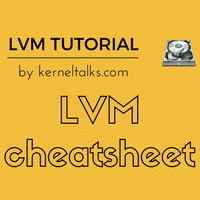List of all LVM command of HPUX tutorials we have seen before on KernelTalks. LVM commands related to physical volume, volume group, and logical volume.

What is LVM?
LVM is a Logical Volume Manager.
LVM is a volume manager in Unix-Linux systems. It used to manage your disks. LVM enables raw disks to be used as a data store, file system defined mount points. LVM helps to manage your disk volumes efficiently for performance and data integrity. VxVM i.e. Veritas Volume Manager is another volume manager that is as popular as LVM.
Previously we have seen a series of LVM command tutorials on KernelTalks. Here is a summary of it along in the form of LVM cheatsheet for your quick reference.
- Also read: Basics of LVM legends
Physical Volume Commands
| | | |
| pvcreate | Create physical volume | Tutorial link |
| pvdisplay | Display physical volume details | Tutorial link |
| pvchange | Activate, de-activate physical volume | Tutorial link |
| pvmove | Move data from one PV to another | Tutorial link |
Volume Group Commands
| | | |
| vgcreate | Create volume group | Tutorial Link |
| vgdisplay | Display volume group details | Tutorial Link |
| vgscan | Rebuild /etc/lvmtab file | Tutorial Link |
| vgextend | Add new PV to VG | Tutorial Link |
| vgreduce | Remove PV from VG | Tutorial Link |
| vgexport | Export VG from system | Tutorial Link |
| vgimport | Import VG into system | Tutorial Link |
| vgcfgbackup | Backup VG configurations | Tutorial Link |
| vgcfgrestore | Restore VG configurations | Tutorial Link |
| vgchange | Change details of VG | Tutorial Link |
| vgremove | Remove VG from system | Tutorial Link |
| vgsync | Sync stale PE in VG | Tutorial Link |
Logical Volume Commands
| | | |
| lvcreate | Create logical volume | Tutorial Link |
| lvdisplay | Display logical volume details | Tutorial Link |
| lvremove | Remove logical volume | Tutorial Link |
| lvextend | Increase size of logical volume | Tutorial Link |
| lvreduce | Decrease size of logical volume | Tutorial Link |
| lvchange | Change details of logical volume | Tutorial Link |
| lvsync | Sync stale LE of logical volume | Tutorial Link |
| lvlnboot | Set LV as root, boot, swap or dump volume | Tutorial Link |
Share Your Comments & Feedback: